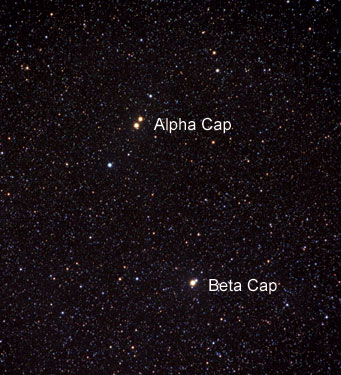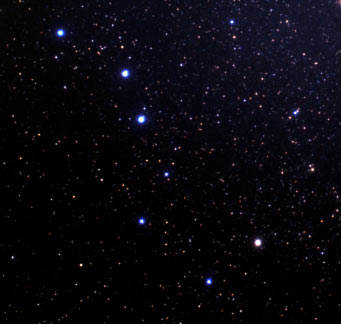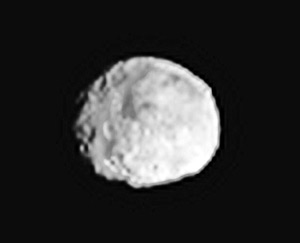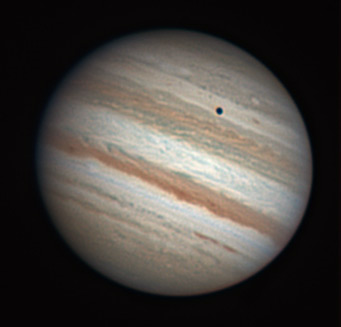
Alpha and Beta Capricorni are 2.3° apart and fit easily into even a 15× field of view. Here they're oriented as they appear from mid-northern latitudes not long after they rise. Both are optical double stars. Alpha can often be split with the unaided eye, but Beta needs optical aid; its components appear closer together, and the fainter one is magnitude 6.0.
Akira Fujii
Friday, July 15
Saturday, July 16
Sunday, July 17

The Big Dipper high in the northwest is starting to dip.
Akira Fujii
Monday, July 18
Look far to the right of Arcturus, at roughly the same height, for the Big Dipper, oriented about as shown here.
Tuesday, July 19
Wednesday, July 20

When DAWN took this image of the asteroid Vesta on June 24th, it was the best image ever obtained of the odd minor planet. Vesta is about 510 km (315 miles) wide. Much better pix are coming as DAWN works its way down into a lower orbit.
NASA / JPL-Caltech / UCLA / MPS / DLR / IDA
Thursday, July 21
Friday, July 22
Saturday, July 23
Want to become a better amateur astronomer? Learn your way around the constellations. They're the key to locating everything fainter and deeper to hunt with binoculars or a telescope.
For an easy-to-use constellation guide covering the whole evening sky, use the big monthly map in the center of each issue of Sky & Telescope, the essential magazine of astronomy. Or download our free Getting Started in Astronomy booklet (which only has bimonthly maps).
Sky Atlas 2000.0 (the color Deluxe Edition is shown here) plots 81,312 stars to magnitude 8.5. That includes most of the stars that you can see in a good finderscope, and typically one or two stars that will fall within a 50× telescope's field of view wherever you point. About 2,700 deep-sky objects to hunt are plotted among the stars.
Alan MacRobert
Once you get a telescope, to put it to good use you must have a detailed, large-scale sky atlas (set of charts). The standards are the Pocket Sky Atlas, which shows stars to magnitude 7.6; the larger Sky Atlas 2000.0 (stars to magnitude 8.5); and the even larger and deeper Uranometria 2000.0 (stars to magnitude 9.75). And read how to use sky charts effectively.
You'll also want a good deep-sky guidebook, such as Sky Atlas 2000.0 Companion by Strong and Sinnott, or the more detailed and descriptive Night Sky Observer's Guide by Kepple and Sanner, or the classic if dated Burnham's Celestial Handbook.
Can a computerized telescope take their place? I don't think so — not for beginners, anyway, and especially not on mounts that are less than top-quality mechanically. As Terence Dickinson and Alan Dyer say in their Backyard Astronomer's Guide, "A full appreciation of the universe cannot come without developing the skills to find things in the sky and understanding how the sky works. This knowledge comes only by spending time under the stars with star maps in hand."
This Week's Planet Roundup
Mercury (about magnitude +0.3) remains very low in the west-northwest in twilight, now becoming a little lower each day. Don't confuse it with Regulus to its upper left. Mercury and Regulus will pass 3° apart on July 26th.
Venus is hidden deep in the glow of sunrise.
Mars (magnitude +1.4, in Taurus) is moderately low in the east-northeast as dawn begins to brighten. Look for it very far lower left of bright Jupiter. To Mars's right or upper right is Aldebaran, similar in brightness and color. Farther to Mars's upper left is brighter Capella.
In a telescope Mars is still just a tiny blob only 4.3 arcseconds in diameter. It's on its way to a poor opposition (13.9 arcseconds wide) next March.

Jupiter on the morning of July 28th, imaged by S&T's Sean Walker. The South Equatorial Belt (above center) remains wide; the North Equatorial Belt remains narrow and darker red-brown. The black dot is the shadow of Io. Walker used a 12.5-inch Newtonian telescope and an Imaging Source camera in "fairly good" seeing.
S&T: Sean Walker
Jupiter (magnitude –2.3, in southern Aries) rises around 1 a.m. daylight saving time and shines high in the east-southeast by dawn. Look below it for the head of Cetus, rather dim.
Saturn (magnitude +0.9, in Virgo) is sinking lower in the west-southwest at dusk. Shining 14° left of it is similar, but bluer, Spica. About 1° to Saturn's right is fainter Porrima (Gamma Virginis).
Uranus (magnitude 5.9, in western Pisces) and Neptune (magnitude 7.9, in western Aquarius) are up in good view during the early-morning hours. Here's our printable finder chart for them both.
Pluto (magnitude 14.0, in northern Sagittarius) is highest in the south around 11 or midnight. A big finder chart for it is in the July Sky & Telescope, page 64.
All descriptions that relate to your horizon — including the words up, down, right, and left — are written for the world's mid-northern latitudes. Descriptions that also depend on longitude (mainly Moon positions) are for North America. Eastern Daylight Time (EDT) equals Universal Time (also known as UT, UTC, or GMT) minus 4 hours.
To be sure to get the current Sky at a Glance, bookmark this URL:
http://SkyandTelescope.com/observing/ataglance?1=1
If pictures fail to load, refresh the page. If they still fail to load, change the 1 at the end of the URL to any other character and try again.
 0
0
Comments
You must be logged in to post a comment.